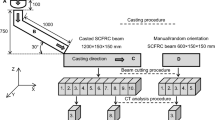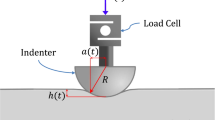Abstract
This paper deals with two simple and cheap techniques to quantify the workability of Self Compacting Concrete (SCC). The first one is the standard slump flow test. It is demonstrated that, although the slump flow test is a good quality control empirical test, it is not correlated to the yield stress of the tested material as the thickness of the sample at flow stoppage is of the same order as the size of the largest particles. The second test, the LCPC box, is an alternative new test developed at LCPC. It fulfills all the conditions needed to correlate the measured empirical value to the yield stress of the SCC tested. The analysis, the description and the protocol of this new test are described in this paper.
Résumé
Deux essais permettant la quantification de l’ouvrabilité d’un Béton AutoPlaçant (BAP) sont analysés. Le premier est l’essai standard d’étalement. Nous démontrons que, malgré le fait que cet essai soit un essai de réception et de contrôle de qualité adapté, il n’est pas corrélé comme le cône d’Abrams au seuil d’écoulement du béton testé, l’épaisseur de l’échantillon à l’arrêt de l’écoulement étant du même ordre de grandeur que les granulats constitutifs. Le deuxième test, l’essai à la boite LCPC, est une nouvelle méthode alternative de mesure du seuil d’un BAP qui remplit toutes les conditions théoriques pour corréler le seuil du matériau à la grandeur mesurée. L’analyse de l’essai, sa description et son protocole opératoire clôturent l’article.









Similar content being viewed by others
References
de Larrard F, Hu C (1996) The rheology of fresh high-performance concrete. Cem Concr Res 26(2):283–294
Operating manual, the BML viscometer, the viscometer 4, Con Tec, 2000
Tatersall GH, Bloomer SJ (1979) Further development of the two-point test for workability and extension of its range. Mag Concrete Res 31:202-210
Ferraris CF, Brower LE (eds) (2004) Comparison of concrete rheometers: International tests at MB (Cleveland OH, USA) in May, 2003. National Institute of Standards and Technology Internal Report 7154
Coussot P, Ancey C (1999) Rhéophysique des pâtes et des suspensions, EDP Sciences, (in French)
Ferraris CF, Brower LE (eds) (2001) Comparison of concrete rheometers: International tests at LCPC (Nantes, France) in October, 2000. National Institute of Standards and Technology Internal Report 6819
Murata J (1984) Flow and deformation of fresh concrete. Mater Struct 98:117–129
Roussel N, Coussot P (2005) “Fifty-cent rheometer” for yield stress measurements: from slump to spreading flow. J Rheol 49(3):705–718
Pashias N, Boger DV, Summers J, Glenister DJ (1996) a fifty cent rheometer for yield stress measurements. J Rheol 40(6):1179–1189
Schowalter WR, Christensen G (1998) Toward a rationalization of the slump test for fresh concrete: comparisons of calculations and experiments. J Rheol 42(4):865–870
Clayton S, Grice TG, Boger DV (2003) Analysis of the slump test for on-site yield stress measurement of mineral suspensions. Int J Miner Proce 70:53–21
Saak AW, Jennings HM, Shah SP (2004) A generalized approach for the determination of yield stress by slump and slump flow. Cem Concr Res 34:363–371
Nguyen QD, Boger DV (1985) Direct yield stress measurement with the vane method. J Rheol 29:335–347
Roussel N, Stefani C, Le Roy R, (2005) From mini cone test to Abrams cone test: measurement of cement based materials yield stress using slump tests. Cem Concr Res 35:817–828
Wallevik O (2003) Rheology—a scientific approach to develop self-compacting concrete. In: Proceedings of the 3rd international RILEM Symposium on Self-Compacting Concrete, RILEM PRO33 Reykjavik, Iceland, pp 23–31
N’Guyen TLH, Roussel N, Coussot P (2006) Correlation between L-box test and rheological parameters of an homogeneous yield stress fluid. Cem Concr Res 36:1789–1796
Acknowledgements
The author would like to thank Thi Lien Huong N’Guyen and Z. Toutou for their experimental contribution to the present work and P. Coussot for the always useful discussions.
Author information
Authors and Affiliations
Corresponding author
Rights and permissions
About this article
Cite this article
Roussel, N. The LCPC BOX: a cheap and simple technique for yield stress measurements of SCC. Mater Struct 40, 889–896 (2007). https://doi.org/10.1617/s11527-007-9230-4
Received:
Accepted:
Published:
Issue Date:
DOI: https://doi.org/10.1617/s11527-007-9230-4




